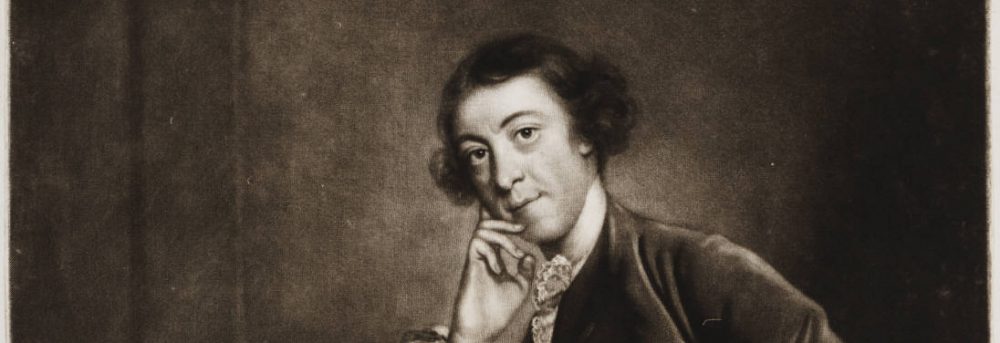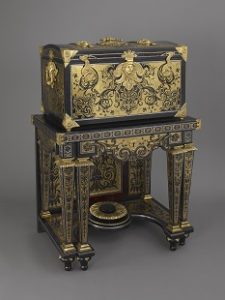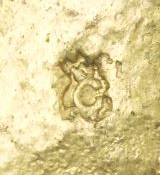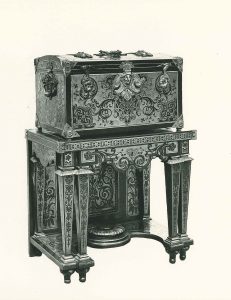The Boulle Coffer on Stand in the Collection of the Lewis Walpole Library
by Susan Walker, Head of Public Services
The coffer on stand by André Charles Boulle, now in the collection of the Lewis Walpole Library, first appeared in Horace Walpole’s 1774 A Description of the Villa in the Round Drawing Room as “A trunk of tortoiseshell and bronze; by Boul, on a frame of the same; a small jar of Seve china under it.”
It is possible that Walpole saw and purchased the piece during one of his trips to Paris. In the list of his shipments of 1766 are “Two large cases H.W. from Poirier’s with clock, secrétaire, coffre and table. Two red leather chairs.” The LWL’s Boulle coffer on stand is a very tempting candidate for that “coffre and table.”
By the time it appeared as lot 25 on day 23 of the Strawberry Hill sale in 1842, the piece was described with a bit more detail and enthusiasm by the auctioneer George Robins as “A remarkably fine Old Boule Coffer, a splendid specimen of this work, at an early period, the front elaborately finished with tortoiseshell ground work, massive or-molu mountings, masque handles, chased rosette corners, and lined with blue silk, on a pedestal en-suite, with richly worked boule back and stand for porcelain.”
It was bought by the dealer Owen of New Bond Street for £44.2.0. Was he buying for a collector? The piece reappeared as the Property of Sir Herbert Ogilvy, Baldovan House, Dundee, at a Sotheby’s auction on 9-10 November 1922 for £100. By the time it came to auction, its association with Walpole, Strawberry Hill, and the display of porcelain had transformed into a thing of family legend: “This coffer, with its stand, was Lot 25 in the Twenty-third Day’s sale of the contents of Strawberry Hill (May 20, 1842, Catalogue, p. 230). It was purchased at the sale by the present owner’s great-grandfather, the first Baron de Mauley; there has always been a tradition in the family that on the stand below the coffer reposed the famous bowl of goldfish in which Horace Walpole’s cat was drowned—a melancholy event commemorated by Thomas Gray in his poem ‘On the Death of a Favourite Cat.’” (Sotheby, 1922). The coffer on stand was bought in, so Ogilvy tried again through Sotheby’s on 6 December 1935, when it was bought by a purchaser named Seymour for £15. It has been suggested that “Seymour” may have been a dealer operating at auction under the assumed name of a famous family of collectors of French furniture at the time.
In January 1939, just shy of a century after the 1842 Strawberry Hill sale, W.S. Lewis purchased the coffer on stand from owner W.P. Wilson of Sennicots, Chichester, through the London dealer Ifan Kyrle Fletcher. Lewis, in his quest for Walpole correspondence for his Yale Edition, placed ads in the Times (London) personal column. He received an answer to one from Wilson in January of 1937, informing him of his ownership of the Boulle coffer on stand. Mr. Wilson had the piece photographed in May of that year, and in December 1938, Fletcher wrote to Lewis to say he had been in touch with the owner who was willing to sell it for £160. The deal was done, and the piece shipped to Farmington. The piece was bequeathed along with the collection, buildings, and property to Yale University on Lewis’s death in 1979.
The Lewis Walpole Library’s piece is thought to date from the first quarter of the eighteenth century and have been made by master ébéniste André-Charles Boulle or one of his sons. Boulle popularized this use of foliate and arabesque tortoiseshell and brass marquetry which came to be named after him (Boulle, boullework, or buhl). Most of the surface decoration on the LWL’s coffer is brass, with the tortoiseshell inlaid into it, a combination referred to as contre partie marquetry. Each such piece has a mate with the opposite treatment of the veneers. Thus, the mate to the LWL’s coffer, displaying première partie marquetry of tortoiseshell with inlaid brass, is in the Art Institute of Chicago’s collection.
The ormolu or gilt bronze mounts bear the crown c stamp (or poinçon c coronné), a tax stamp used from 1745-1749 that indicates the piece was either on the market or having such work done as having the mounts regilded during those years.
A remarkable survival of Boulle’s production, the LWL’s Boulle coffer on stand, unlike so many pieces made of oak with ebony, tortoiseshell, and metal marquetry veneers, had undergone very little intervention in the twentieth century. Only once sent to the Yale University Art Gallery for structural stabilization, the piece retained original materials and thus was an important document with evidence of the practices of the eighteenth-century French workshop. In 2006, the Library was awarded a generous grant from The Getty Foundation for treatment and research related to the conservation of the piece.
A team composed of Head of Public Services Susan Walker, then-Head of Research at the Victoria & Albert Museum Carolyn Sargentson, and conservator Yannick Chastang, collaborated on decisions involving all aspects of the piece’s treatment. Through face-to-face meetings and email correspondence, the trio reached agreement on the work to be performed. They agreed that the piece should be taken back to its appearance in the earliest image found—the photograph taken in Chichester in 1937.
One question that arose was whether to re-engrave the early replacement brass in the center front.
The decision was made not to attempt any engraving as it appeared without it in the early photo and there was a risk of damage to the piece if attempted.
Another question was whether to reproduce an escutcheon on the drawer that appeared in the 1937 photo but had subsequently been lost.
A replica was made based on the design shown in the photo, but it is not consistent with any known Boulle mount.
Finally, a long debate centered on whether to install any decorative element on the top of the plinth on the stand. There were many different examples found on similar pieces, but no description or any surviving evidence in the photo or on the plinth itself led to a convincing solution, nor would any have allowed for the display of a piece of porcelain, so the decision was made to leave the plinth unadorned.

Arlen Heginbotham, Assistant Conservator of Decorative Arts and Sculpture at the J. Paul Getty Museum, led the examination and research carried out at the Getty Museum and the Getty Research Institute where the piece underwent scientific analysis for materials identification. The red marquetry at the back panel of the stand revealed vermilion, red lead, and lead white, while the surprising discovery of the use of carbon black and natural vermilion pigments under the tortoise shell on the front of the coffer indicated the shell there would appear nearly black. The coffer on stand’s appearance now reflects the period materials discovered during its examination and, with the use of appropriate black coloring under the shell, the black and gold Walpole favored for frames and other furniture at Strawberry Hill. During treatment, tucked underneath the later red silk fabric lining the coffer, a small fragment of the early blue silk lining was discovered, consistent with the 1842 Sale description, and confirming the link to Walpole.
The Boulle coffer on stand from Horace Walpole’s collection at Strawberry Hill is now on view in the Lewis Walpole Library’s Reading Room.
Bibliography
Robins, George, A Catalogue of the Classic Contents of Strawberry Hill Collected by Horace Walpole, April 25th 1842 and 23 following days. (London: Smith and Robins, 1842)
Walpole, Horace. A Description of the Villa of Horace Walpole, Youngest Son of
Sir Robert Walpole Earl of Orford, at Strawberry-Hill Near Twickenham, Middlesex. With an Inventory of the Furniture, Pictures, Curiosities, &c (Strawberry-Hill: Printed by Thomas Kirgate, 1774).
Walpole, Horace. The Yale Edition of Horace Walpole’s Correspondence, edited by W.S. Lewis et al. 48 vols. London: Oxford University Press, 1937–83.





